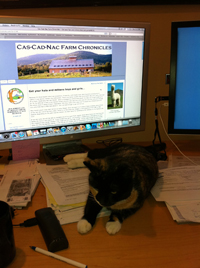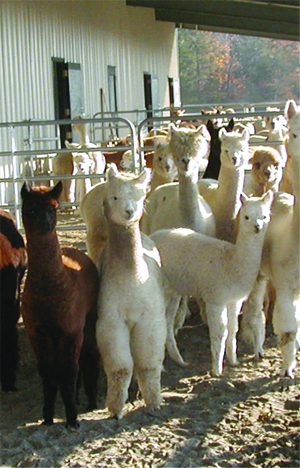Herd Health Management the CCNF Way
Why create all new content when I can plagiarize myself?! I’m blaming my kitty, Jewel, as she is after all my muse. Yes, yes, please suspend your disbelief and pretend for just one brief moment that something posted here could actually have been inspired. Anyway I digress, the bottom line is that the whole plagiarizing idea was the cat’s fault. Doesn’t she look guilty?

The post that follows is actually a (very lightly) edited and updated reprint of an article I wrote for the Autumn 2005 issue of Cas-Cad-Nac Farm Chronicles, the quarterly newsletter that begat this blog. I decided that since the CCNF afterguard will be freezing it’s collective arse off this morning restraining, body scoring, and trimming the toe nails of +/- 230 alpacas that this was as good a moment as any to revisit this piece. Rereading it last night in preparation for today’s posting I was struck by the fact that we haven’t fundamentally altered the way we do the vast majority of our herd management in the five years since this was first written. That means that either we are stubborn, ignorant buffoons who have no clue…or that it all actually works. In any case, please read on.

The most frequent interactions we have with people who have just purchased their first alpacas relate to how they should go about addressing the question of their herd health management. The reality is that a majority of new alpaca owners have never spent much (if any) time with a farm animal prior to acquiring their new camelid friends. Though real enthusiasm can cover quite a lot there are many new owners who inevitably have an “uh, oh…now what do I do!?” moment when their critters first come home. Obviously when starting out it’s a really good idea, if at all possible, to get connected with a good large animal vet who will hopefully become your long term partner in the care of your alpacas, whether in charting a course for routine preventative care or dealing with the slightly more exotic and exciting medical issues when they inevitably show their big bad selves. I realize that experienced camelid veterinarians are in short supply. If you are fortunate enough to have one nearby you are truly in the minority. In the more likely event that that is not the case however we will certainly settle for any DVM/VMD who is a willing partner in crime, happy to ask questions of others and learn as they go. There is also something to be said for buying your alpacas, particularly your first ones, from breeders who offer good support after the sale, even if that means just being willing to field your phone calls and talk you through things, whether big or small, as they come up.
With a herd of 200+ we have learned to manage most of our herd health ourselves and at this point our vets are really only coming out for one of 3 things: 1. rabies shots, 2. repro work-ups, or 3. when the proverbial you-know-what has hit the fan and an animal is in very serious trouble. While I will certainly grant that there are many different styles and philosophies of management, at the end of the day there are certain commonalities that can be applied to the process whether you have 5 alpacas or 500. When our management plan and its techniques (or some similar variation thereof) are applied, the result is a highly organized, streamlined, and efficient system that minimizes stress on alpacas and humans alike. I know that sounds like so much drivel. The reality though is that 4 people working in teams of 2 here at CCNF can de-worm, vaccinate, and trim the nails of @240 alpacas in roughly 8 hours all while keeping track of what they’re doing and keeping careful notes that then relate back to the nutritional management of every individual alpaca on this farm. Talk is cheap but the fact is that this stuff works. Here are a few ground rules we live by…
Ground Rule 1. Good record keeping is a must. Whether you would prefer to use a software program ( as of 2010 CCNF uses a networked version of AlpacaEase), a handwritten file for each alpaca, or some variation in between, herd health management becomes much easier when you have good records to refer back to. Our herd health record keeping has two layers. The first is a daily log book in each major barn which contains entries for any meds given, crias born, animal movement both within the farm as well as departures and arrivals, as well as records of any medical events or observations (i.e. diarrhea seen in North 1). The notes written in the log book are then transferred to the electronic files for the respective alpaca in our database (backed up early and often) which then forms the long term backbone of our herd’s medical and management history. In addition to noting the births of new crias in the actual log book, with each newborn we also produce a hardcopy page which becomes that cria’s weight chart for the first six months of it’s life, as well as a record of any other neonatal-related things: when it started nursing independently, notes from its neonatal wellness check and a list of initial vaccines, IgG, total blood protein, etc…By frequently updating our database with all of that (hello Kimberly!) we are then able on herd health days to print out records, organized by pen/feed group, which tell us exactly what each alpaca needs for routine care as well as anything extra we have noted from either the previous month’s session (herd health days take place roughly every 30 days) or on an ongoing basis. There are also notes in each animal’s file, and thus the resulting printout, pertaining to each individual alpaca’s body score, though I will touch more on the importance of that a bit later in ground rule 3.
Ground Rule 2. You cannot be afraid or nervous about holding and restraining your animals. In a worst case scenario with a totally raw and untrained alpaca it’s still only a matter of learning how to gain body position and leverage on them. The very worst they (usually grumpy pregnant females especially) can do is spit at you. I know it smells bad but it is after all just partially digested grass and hay not hydrochloric acid. With a little practice in restraint (the grumpier the alpaca, the closer you hold it: counterintuitive I know) you can avoid most of that soap opera anyway. We obviously don’t have time here to train each and every animal and warm the entire herd to the notion of having human hands on them. While those members of the CCNF herd that were born here have all gotten at least some measure of desensitization training by virtue of our interaction with them at birth (if they are not actually halter trained), others are 14 year old imported females who were plucked off the Peruvian Altiplano and as such their feelings towards humans, deservedly so I might add, are not so dissimilar from their feelings towards pumas. Are there ways you can train your alpacas so that they will stand and let you, even single handedly, give them vaccinations or trim their nails? Yes, absolutely. The training techniques to instill that trust/desensitization in alpacas are all well documented and when done correctly can work magic. I don’t dispute that for one moment. However done incorrectly they can turn a slightly edgy alpaca, who’s simply not really into humans and wants its space, into a complete and utter head case. Remember that the alpaca is a domesticated prey species. Their survival in their native lands depends greatly upon their rather keen ability to sense and detect threats. Want to see an alpaca get all wound up? Try locking it in a confined space for hours at a time in anticipation of veterinary work when it’s only association with being confined is veterinary work. We feel like the best way to do vaccinations and other herd health stuff is to bring an entire given group of animals into a rather small catch pen (too much space = more running = more stress) at the last moment, having previously drawn up any necessary vaccines. Administer the shots in a quick and orderly fashion, trim each animal’s toe nails if needed and then let it go. Catching an alpaca multiple times so it can “calm down” between each shot is a fallacy created by people who are conveniently and arbitrarily anthropomorphizing because it makes them feel better. The quicker one’s work with a high strung animal is completed, the better. We do this in teams of two people: one holder and one shot giver & nail trimmer. Sexy? No. Effective, fast, and relatively stress free? You bet.
Ground Rule 3. Nutritional management of your herd merely requires putting your hands on your alpacas and some common sense. Did you notice how all 60,000 people at any given football stadium have exactly the same body type and therefore presumably the same exact metabolism? Me neither. Alpacas are no different than people when it comes to body type and metabolic rates, there is a great variation. Some can easily maintain healthy body condition just eating hay and/or pasture while others could eat high protein grain all day and still run on the thin side. During the summer months there is a considerable percentage of the herd here that is living beneath the stars getting nothing more than pasture, water, and access to an outside mineral feeder. Conversely we have some older females, though admittedly a much smaller group, that will get free choice hay and grain almost year round. The key to successfully managing the nutritional health of your alpaca herd, whether 2 animals or 2000, is familiarizing yourself with the metabolisms of your alpacas and learning how to body score them with a set body score target in mind based upon their age, the time of year, and where applicable, their pregnancy status. Then keep records of it. This isn’t rocket science. If they’re thin: feed them a little more (supplementary grain ration). If they are running heavy: feed them a little less. It’s somewhat akin to Dr. Spock’s famous axiom to new parents that you know more than you think you do, just trust your instincts. We feel that all things being equal (this assumes a healthy animal within the normal size range for its age) once a cria is weaned from it’s dam you can essentially stop using the weight scale as a management tool and manage the animal’s nutrition purely on the basis of it’s body score. That’s not to say that having a record of each adult’s healthy base weight is not a good idea but we are generally more inclined to trust what our hands are telling us about a given animal’s top line than what we see on an electronic readout. After we have done herd health day we then take those alpacas that appear to need a little more nutrition and move them to an appropriate feed group. Likewise for those that are running a little heavy. Here again it’s nothing terribly complex or hard to learn, it just requires a little practice.
